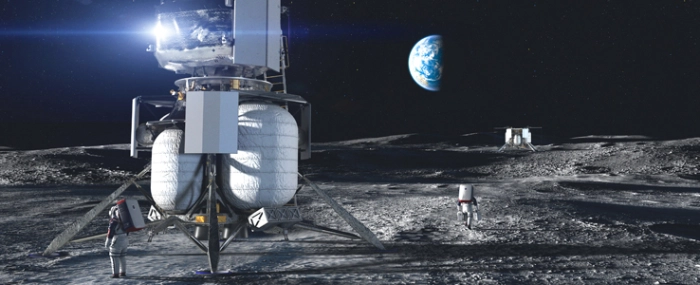
© Blue Origin
Electronics Production |
We’re going back to the moon - and Blue Origin will lead the way
On the last day of April, the Blue Origin National Team, which includes Lockheed Martin, Northrop Grumman, and Draper, was selected by NASA to begin to develop the Artemis Human Landing System for which the ultimate goal is to return humans to the moon.
“NASA’s Artemis program will be the next major milestone in the history of human space flight, and we’re honored to be a part of it,” says Bob Smith, CEO, Blue Origin, in a press release announcing the project.
Using existing and in development technologies provides the head start needed to meet NASA’s goal of landing at the South Pole of the Moon. Lockheed Martin’s Ascent Element is based on Orion; Northrop Grumman’s Transfer Element is based on Cygnus; and Blue Origin’s Descent Element is based on the Blue Moon lander and BE-7 engine, which has been in development for several years.
“Our National Team brings unparalleled heritage, passion and innovation that will enable Americans to return to the lunar surface and inspire another generation. It’s time to go back to the Moon, this time to stay,” Smith continues.
Blue Origin will function as the prime contractor, leading program management, systems engineering, safety and mission assurance. Adding to this Blue Origin will also take charge of mission engineering and operations as well as developing the Descent Element.
Lockheed Martin is tasked with developing the reusable Ascent Element vehicle and leads crewed flight operations and training.
Northrop Grumman will be developing the Transfer Element vehicle that delivers the landing system into low lunar orbit for final descent. Draper will be leading descent guidance and provides flight avionics.
“The Artemis astronauts will descend to the surface and ascend off the surface inside an advanced crewed ascent element. The best way to accomplish this safely and quickly is to leverage NASA’s investment in Orion, an existing human-rated deep space spaceship, which maximizes common training and operations,” says Rick Ambrose, executive vice president, Lockheed Martin Space, in the press release..
“Putting humans back on the lunar surface is an inspiring goal for our nation,” adds Blake Larson, corporate vice president and president of Northrop Grumman Space Systems. “We are proud to support this team and NASA with our decades of experience, comprehensive capabilities, and our proven space systems, as we return to the Moon.”



